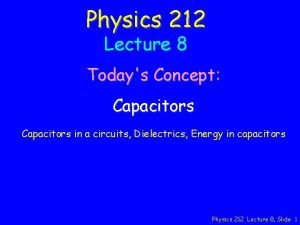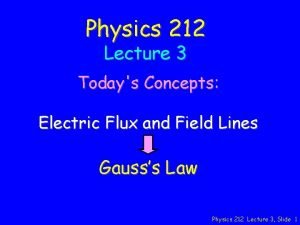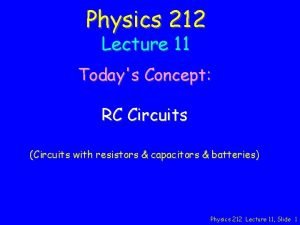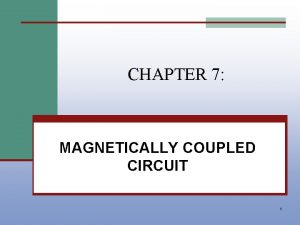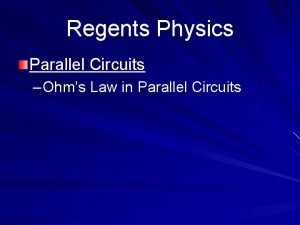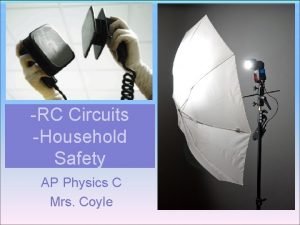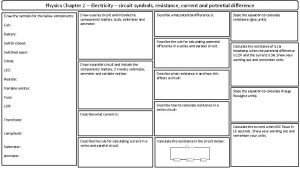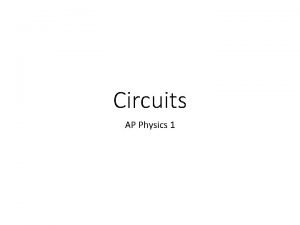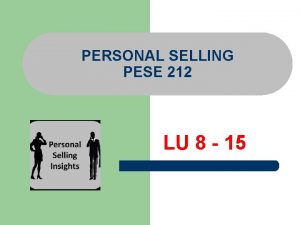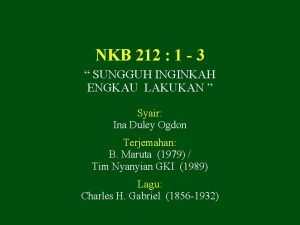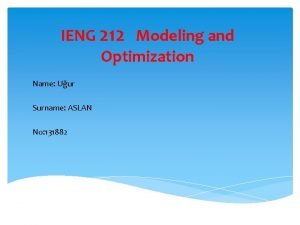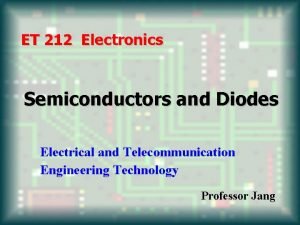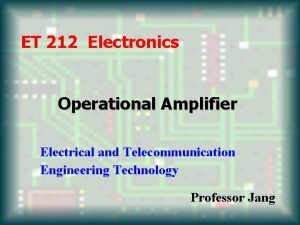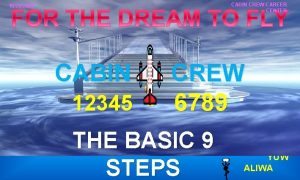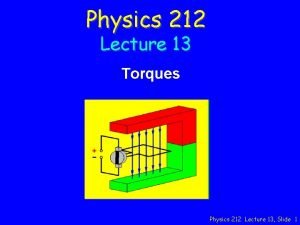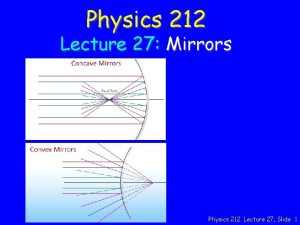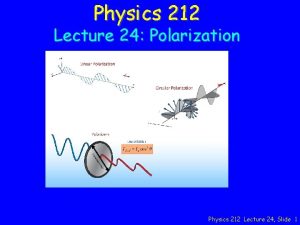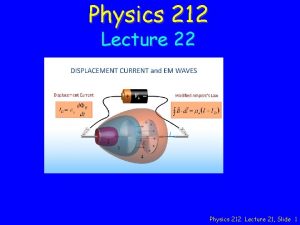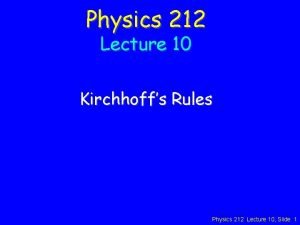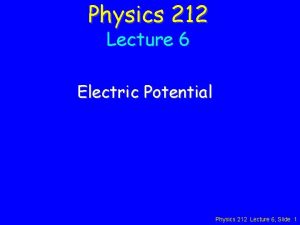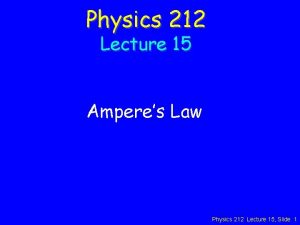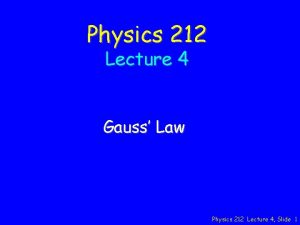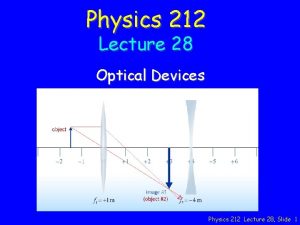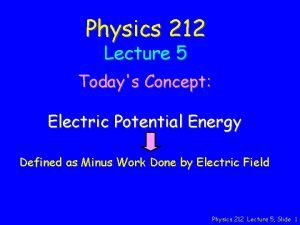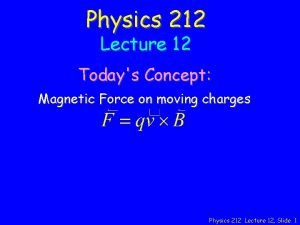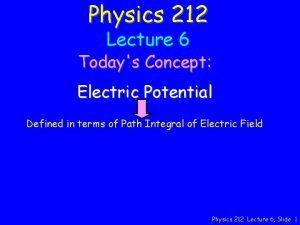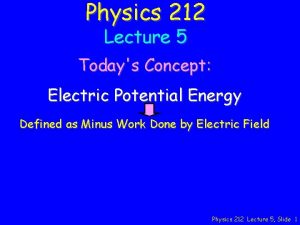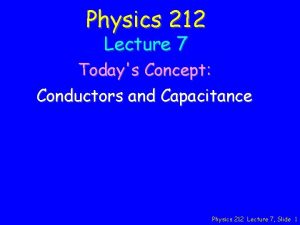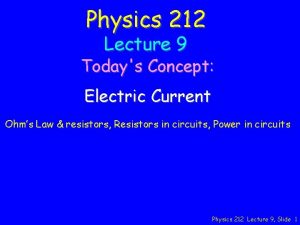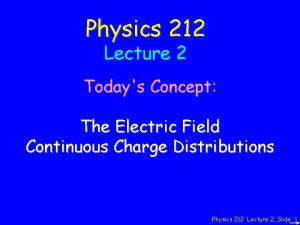Physics 212 Lecture 11 Todays Concept RC Circuits






















- Slides: 22

Physics 212 Lecture 11 Today's Concept: RC Circuits (Circuits with resistors & capacitors & batteries) Physics 212 Lecture 11, Slide 1

Main Point 1 First, just as in the last prelecture, to analyze any circuit, we only need apply two rules: Kirchhoff’s Voltage and Current Rules. In this prelecture we applied Kirchhoff’s voltage rule to solve for the current in RC circuits which have only one node. The new wrinkle here is that the equation we obtained was a differential equation which resulted in a time-dependent current. Physics 212 Lecture 11, Slide 2

Main Point 2 Second, the solutions to the differential equations we obtained were exponential in time, being characterized by a single time constant which is equal to the product of an equivalent resistance and an equivalent capacitance. For example, for a circuit that charges a single capacitor C through a single resistor R, we found that the current decreases as e-t/t, while the charge on the capacitor increases as (1 -e -t/t), where the time constant t (tau) is just equal to R times C. Similar results are Physics 212 Lecture 11, Slide 3 found for discharging the circuit.

Main Point 3 Third, in considering the energy flow in the RC charging circuit, we determined that the rate at which energy is being supplied to the circuit by the battery is equal to the rate at which energy is dissipated in the resistor plus the rate at which it is stored in the capacitor. Since the current is decreasing exponentially over time, all of these energy rates asymptotically approach zero as shown. Physics 212 Lecture 11, Slide 4

RC Circuit (Charging) • Switch is moved to position “a” • Kirchoff’s Voltage Rule a E • Short Term (Q=0) C b R • Long Term (Ic =0) • Intermediate Physics 212 Lecture 11, Slide 5

A circuit is wired up as shown below. The capacitor is initially uncharged and switches S 1 and S 2 are initially open. Checkpoint 1 a & Checkpoint 1 b Close S 1, V 1 = voltage across C immediately after V 2 = voltage across C a long time after 13 A) V 1 = V B) V 1 = 0 C) V 1 = 0 V 2 = V V 2 = 0 D) V 1 = V V 2 = 0 Physics 212 Lecture 11, Slide 6

Physics 212 Lecture 11, Slide 7

A circuit is wired up as shown below. The capacitor is initially uncharged and switches S 1 and S 2 are initially open. Checkpoint 1 c IR + - After being closed a long time, switch 1 is opened and switch 2 is closed. What is the current through the right resistor immediately after switch 2 is closed? A A. IR = 0 B. IR = V/3 R C. IR = V/2 R D. IR = V/R B C D 22 Physics 212 Lecture 11, Slide 8

Physics 212 Lecture 11, Slide 9

A circuit is wired up as shown below. The capacitor is initially uncharged and switches S 1 and S 2 are initially open. Checkpoint 1 d Now suppose both switches are closed. What is the voltage across the capacitor after a A very long time? B A. VC = 0 B. VC = V C. VC = 2 V/3 C 26 Physics 212 Lecture 11, Slide 10

Physics 212 Lecture 11, Slide 11

RC Circuit (discharging) • Switch is moved to position “b” • Kirchoff’s Voltage Rule a E C b R • Short Term (Q=Q 0) • Long Term (Ic=0) • Intermediate Physics 212 Lecture 11, Slide 12

Bulb DEMO V BB Bulb 2 S Bulb 1 R R C What will happen after I close the switch? A) B) C) D) Both bulbs come on and stay on. Both bulbs come on but then bulb 2 fades out. Both bulbs come on but then bulb 1 fades out. Both bulbs come on and then both fade out. Suppose the switch has been closed a long time. Now what will happen after open the switch? A) B) C) D) Both bulbs come on and stay on. Both bulbs come on but then bulb 2 fades out. Both bulbs come on but then bulb 1 fades out. Both bulbs come on and then both fade out. Physics 212 Lecture 11, Slide 13

Physics 212 Lecture 11, Slide 14

Calculation S R 1 R 2 V C In this circuit, assume V, C, and Ri are known. C initially uncharged and then switch S is closed. R 3 After a long time S is opened: What is the charge on the capacitor after switch 1 has been closed a long time? • Conceptual Analysis: • Strategic Analysis Physics 212 Lecture 11, Slide 15

Physics 212 Lecture 11, Slide 16

Physics 212 Lecture 11, Slide 17

Exponentials (e) This is the value that makes slope equal to the function e = 2. 718281… 1/e = 0. 367879… Physics 212 Lecture 11, Slide 18

Time Constant (t=RC) Charge as a function of time for discharging two different RC circuits. Which circuit has the larger time constant? A) A B) B C) Same B A Physics 212 Lecture 11, Slide 19

The two circuits shown below contain identical capacitors that hold the same charge at t = 0. Circuit 2 has twice as much resistance as circuit 1. Checkpoint 2 a Which circuit has the largest time constant? A) Circuit 1 B) Circuit 2 C) Same 49 Physics 212 Lecture 11, Slide 20

The two circuits shown below contain identical capacitors that hold the same charge at t = 0. Circuit 2 has twice as much resistance as circuit 1. Checkpoint 2 b Which of the following statements best describes the charge remaining on each of the two capacitors for any time after t = 0? A. Q 1 < Q 2 B. Q 1 > Q 2 C. Q 1 = Q 2 D. Q 1 < Q 2 at first, then Q 1 > Q 2 after long time E. Q 1 > Q 2 at first, then Q 1 < Q 2 after long time 50 Physics 212 Lecture 11, Slide 21

Physics 212 Lecture 11, Slide 22
 Physics 212 gradebook
Physics 212 gradebook Physics 212 gradebook
Physics 212 gradebook Advantages of parallel circuit over series circuit
Advantages of parallel circuit over series circuit Todays concept
Todays concept Magnetically coupled circuits lecture notes
Magnetically coupled circuits lecture notes 01:640:244 lecture notes - lecture 15: plat, idah, farad
01:640:244 lecture notes - lecture 15: plat, idah, farad Parallel circuit laws
Parallel circuit laws Chapter 35 electric circuits
Chapter 35 electric circuits Ap physics c rc circuits
Ap physics c rc circuits Physics symbols electricity
Physics symbols electricity Ap physics circuits
Ap physics circuits Classical mechanics
Classical mechanics Physics 101 lecture notes pdf
Physics 101 lecture notes pdf Physics 101 lecture 1
Physics 101 lecture 1 Physics 101 lecture notes pdf
Physics 101 lecture notes pdf Wave pdf download
Wave pdf download Atmospheric physics lecture notes
Atmospheric physics lecture notes Pese 212
Pese 212 Sungguh inginkah engkau lakukan
Sungguh inginkah engkau lakukan Ienf 212
Ienf 212 Et 212
Et 212 Et 212
Et 212 12345 6789 10
12345 6789 10
